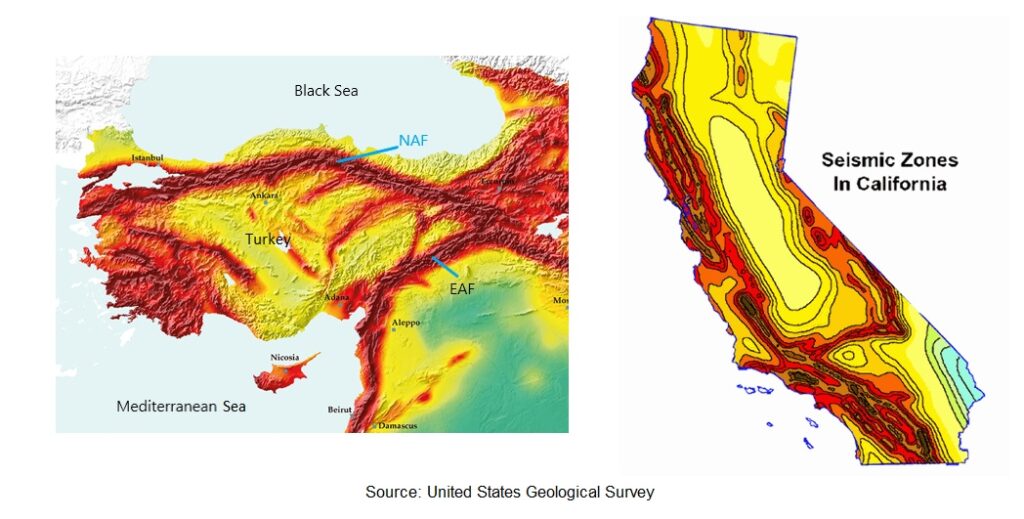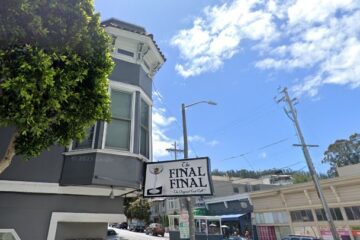Could a Turkey Style Earthquake Happen in California?

Between Turkey and Syria, nearly eight thousand lives were lost when a string of devastating earthquakes pummeled the region.
Turkey’s tectonic predicament, responsible for the massive quake that struck Kahramanmaras at 4:17 Monday morning, looks awfully familiar.
The tectonic situation in Turkey nearly mirrors California’s. Similar mechanics are at work here. Our dominant faults shove landmasses past one another in opposing directions, much like theirs. The major difference is, whereas we have two plates at war underneath us, they have three. That makes for more frequent earthquakes, at least compared to what we get. The Golden State has not witnessed a M7.8 or stronger in 117 years.
It’s a different story in Turkey. In 1999, a M7.6 struck the city of İzmit, claiming over twenty thousand lives. An estimated M7.0 in the year 1268 reportedly killed sixty thousand. The last quake to break M7.8 there occurred in 1939, near Erzincan. Over thirty-two thousand people died.
Can Turkey’s most recent seismic disaster occur here? It depends on what you’re asking. If you’re worried the death rate will be comparable, your answer is no. Given the shaky ground on which we live, California has the most stringent standards in the United States. Still, like its moral constitution, America’s building codes meet the bare minimum. They’re built to resist collapse—not remain usable after the fact. The Bay Area’s next big quake will leave far more homeless than dead.
If it’s the earthquake you mean, then absolutely. It’s happened before and it will happen again. It’s no surprise to most Californians that the only fault capable of similar violence here is the San Andreas.
Same Earthquakes, Different Corner of the World
“To get a big earthquake, you need a really long fault,” says seismologist Dr. Lucy Jones. You may know her as the Earthquake Lady. “The length controls the magnitude, and therefore [the San Andreas] has the biggest quakes in the state. And it’s also the fastest-moving, so it tends to have the big earthquakes most often.” She reminds the media every time the ground moves in California with as much patience as any six-year retiree. ABC7 taped this lesson after the 2019 Ridgecrest earthquakes.

Strike-slip mechanisms dominate Turkey (North and East Anatolian Faults) as well as California’s own San Andreas. Both fault systems are capable of generating similarly devastating earthquakes.
No safety in numbers
As the state’s longest fault and principal plate boundary, the San Andreas gets all the glory. But it isn’t the producer of gargantuan earthquakes the movies make it out to be (sorry, Rock). It runs long, 800 miles in fact, but it doesn’t run deep. The resulting fault plane is only twelve miles wide. Too far down and the crust gets too gooey to break cleanly. To get seismic waves, you have to crack solid Earth.
But don’t get complacent. That the San Andreas tops out at around M8.3 makes that eventual quake no less catastrophic. In 1906, over three thousand people died in San Francisco. Seismologists estimate the earthquake was a M7.9, while some put it at M7.8 like the most recent tragedy. Others give it a full, round M8.0.
“A 6.4 is devastating to the people of Ridgecrest. But it doesn’t really affect anybody outside of Ridgecrest, Trona, and China Lake. When we have the San Andreas earthquake, we’ll have ten million people that had the strong shaking Ridgecrest had, or stronger. Therefore, the social scale gets so much larger [than earthquake magnitude], it becomes a very different situation.” – Dr. Lucy Jones, ABC7, July 5, 2019, hours before the M7.1 mainshock
The numbers only seem to matter. Even labels lose their prestige in pale comparison to the amount of lives an earthquake permanently alters, let alone ends. Monday’s quake set off an aftershock sequence that will last for several years. So far the strongest was a M6.7, the same magnitude as the Northridge earthquake of 1994.
How to safely and securely donate to humanitarian and recovery efforts in Turkey and Syria.









